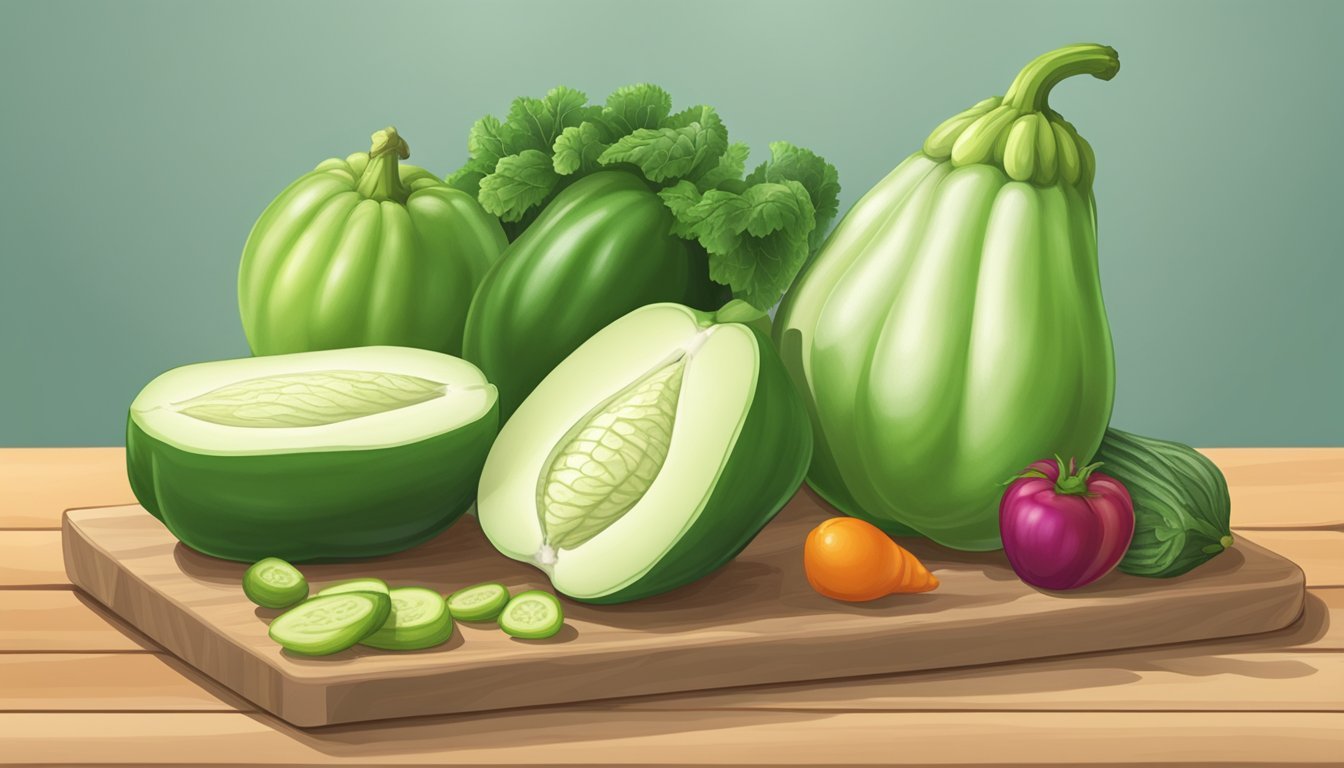Can Diabetics Eat Chayote Squash?
Benefits and Considerations
Managing diabetes effectively requires careful consideration of one's diet, especially when it comes to the inclusion of various fruits and vegetables. Chayote squash, also known as vegetable pear, is one such food that often raises questions regarding its suitability for those with diabetes. It is a type of squash that is low in calories and carbohydrates, making it a potentially good choice for people managing their blood sugar levels.
Chayote is rich in essential vitamins and minerals, such as vitamin C, B vitamins, potassium, and fiber, which play a crucial role in overall nutrition and health. The fiber content in chayote is particularly beneficial for diabetics, as it can help in the slow release of glucose into the bloodstream, thereby preventing spikes in blood sugar levels. Its low carbohydrate count also contributes to better blood sugar control, an important aspect of diabetes management.
Moreover, the consumption of chayote has been associated with anti-inflammatory properties and the potential to reduce oxidative stress. These factors are significant for diabetics, as they are at a higher risk for a range of complications that can be exacerbated by inflammation and cellular damage. Including chayote squash in a diabetic diet could, therefore, offer nutritive benefits while supporting better blood glucose control.
Understanding Diabetes and Blood Sugar Control
Diabetes management is critically influenced by how well blood sugar levels are controlled. This section explores the key dietary factors that impact blood sugar, with a focus on the role of carbohydrates and fiber.
The Impact of Diet on Blood Sugar Levels
The diet is a fundamental aspect influencing blood sugar regulation. In individuals with diabetes, particularly Type 2 diabetes, the body's ability to use insulin effectively is impaired, leading to elevated blood sugar levels. Consuming foods that have a low glycemic index (GI) is essential as they cause a slower rise in blood sugar.
Importance of Carbohydrate Management
Carbohydrates are the primary macronutrients that affect blood sugar levels because they break down into glucose during digestion. Therefore, managing carbohydrate intake is crucial for maintaining optimal blood sugar control in diabetes management. Patients are often counseled to be mindful of both the quantity and types of carbohydrates they consume, opting for complex carbohydrates over simple sugars.
Role of Fiber in Blood Sugar Regulation
Fiber plays a significant role in blood sugar regulation by slowing the absorption of sugar into the bloodstream, resulting in a more gradual increase in blood sugar levels. Diets high in fiber from vegetables, fruits, legumes, and whole grains are beneficial for those managing diabetes. Fiber-rich foods not only aid blood sugar control but also contribute to overall health by providing essential nutrients.
Nutritional Profile of Chayote Squash
Chayote Squash is recognized for its rich nutritional content, offering an assortment of vitamins and minerals while being low in calories. It contributes significantly to a balanced diet with its macronutrients and micronutrients essential for health.
Macronutrient Breakdown
Calories: Chayote squash is low in calories, with approximately 25 calories per cup.
Protein: It provides about 1.1 grams of protein per one-cup serving.
Carbs: A one-cup serving contains 6 grams of carbohydrates.
Fiber: The same serving size has 2.2 grams of dietary fiber.
Fat: Chayote squash contains a negligible amount of fat, with 0 grams per serving.
Vitamins and Minerals in Chayote
Chayote squash is a powerhouse of essential nutrients:
Vitamin C: Supplies over 10 grams, or about 17% of the recommended daily intake (RDI).
Vitamin K: Essential for blood clotting and bone health.
Folate: Provides 123 micrograms of folate, amounting to 31% of the RDI.
Manganese and Copper: Trace minerals important for metabolic function.
Zinc and Magnesium: These minerals support immune function and enzyme activity.
Caloric Value: Low in Calories
Given its nutrient profile, chayote squash is particularly advantageous for those monitoring their calorie intake. With only 19 calories per 100 grams, it is a suitable addition to a diabetic diet, helping to stabilize blood sugar levels while providing essential nutrients.
Health Benefits of Chayote Squash for Diabetics
Chayote squash can be a beneficial addition to a diabetic's diet due to its low glycemic index and nutrient-rich profile that supports blood sugar control and cardiovascular health.
Glycemic Index and Chayote Squash
Chayote squash has a low glycemic index (GI), which means it causes a slower and lower rise in blood glucose levels. This is beneficial for diabetics, as managing blood sugar levels is critical for their overall health. A diet incorporating low GI foods like chayote squash can facilitate better blood sugar control, which is a cornerstone in the management of diabetes.
Anti-Inflammatory Properties
Chayote squash is endowed with anti-inflammatory properties due to its antioxidant content. This can be particularly beneficial for diabetics, as inflammation is a common complication associated with the disease. The antioxidants in chayote squash can help reduce inflammation, supporting a healthier metabolism and potentially mitigating some complications associated with diabetes.
Cardiovascular Health
Individuals with diabetes are often at higher risk for cardiovascular issues, making heart health a priority. Chayote squash contributes to cardiovascular health by delivering nutrients that support the reduction of blood pressure and cholesterol levels. Its potassium content is beneficial in maintaining healthy blood pressure, while its fiber can help manage cholesterol levels, both of which are important for a diabetic's heart health and metabolism.
Incorporating Chayote Squash into a Diabetic Diet
Chayote squash is a versatile addition to a diabetic diet, offering low calories and beneficial nutrients. It can be prepared in various ways that maintain healthy blood sugar levels.
Cooking Methods and Preparation
When incorporating Chayote squash into a diabetic diet, how it is cooked is as important as its inclusion. Chayote can be enjoyed both raw and cooked. Boiling, baking, and roasting are methods that do not require the addition of unhealthy fats or sugars, keeping the glycemic index low. A 100 gram serving of Chayote offers just 19 calories and less than 0.15 grams of fat while being a good source of fiber and essential nutrients like vitamin C and potassium.
Raw: Crunchy and mildly flavored, raw Chayote is a nutritious addition to salads.
Boiled: Gentle boiling preserves nutrients and maintains its low-calorie profile.
Roasted: Roasting concentrates the squash’s natural flavors while keeping it diabetic-friendly.
Chayote's bland flavor makes it ideal for absorbing spices and aromatics, allowing for flavorful meals without excessive carbohydrates.
Recipe Ideas: Soups, Stews, and Salads
Chayote squash can be used in various recipes geared towards diabetic-friendly diets.
Soups and Stews:
Its firm texture withstands slow cooking making it ideal for soups and stews.
Cut Chayote into chunks and add it to vegetable or chicken broth-based soups.
Salads:
Dice Chayote into small pieces for a fresh, crisp addition to green salads.
Combine with leafy greens, a sprinkle of nuts, and a vinaigrette for a balanced meal.
Using Chayote in these dishes ensures a meal that is high in nutrients and fiber, which are crucial for managing diabetes.
Alternative Diabetic-Friendly Squash Varieties
While Chayote is excellent, other squashes can also fit into a diabetic diet.
Zucchini: With a similar nutrient profile to Chayote, it's great in salads or lightly sautéed.
Acorn Squash: A single cup serving of cubed acorn squash contains about 14.6g of carbohydrates; it's richer in flavor but should be eaten in moderation.
Pumpkin: Its seeds are highly nutritious, providing fiber, vitamin K, and valuable minerals such as magnesium and zinc.
These varieties provide diversity for the palate while helping to manage blood sugar levels. They should be prepared using cooking methods that add minimal fats and sugars to keep them suitable for a diabetic diet.





